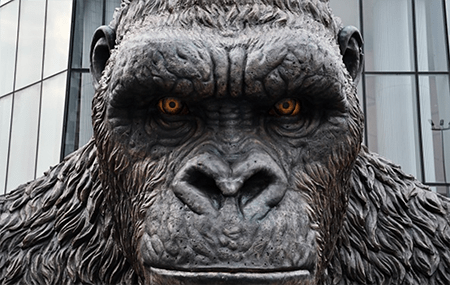Jordan Vogt-Roberts’ “Kong: Skull Island” is the second installment in Warner Bros.’ “monsterverse” following 2014’s “Godzilla.” The eagerly anticipated, follow-up film takes place in 1973 amidst the Vietnam War. Conspiracy theorist government agent Bill Randa, played by John Goodman, takes on the task of traveling to Skull Island, the last known unexplored territory in the world. It’s an island surrounded by hurricanes and lightning constantly and one from where none who entered have returned.
It’s the exact location Randa wants to explore. He hires ex-SAS member James Conrad (Tom Hiddleston) a military squad led by Preston Packard (Samuel L. Jackson), and spunky war photographer Mason Weaver (Brie Larson). The assembled team travels to the island in search of what they think are geological discoveries, but upon arrival they are greeted by much more.
The film is follows the tendencies of a conventional summer blockbuster. It’s an action and adventure film chockfull of explosions, gun battles and cheesy one-liners. What separates the film from the monotonous, bland and cliché action movies are side stories throughout. While many of these disaster films follow a basic plot line of getting trapped and finding an escape, “Kong: Skull Island” has a series of well thought-out and interesting subplots that wind throughout the film. With such a large and talented cast it’s a relief that the script kept each character invested in their own interest and finished multiple storylines rather than merely having background characters as fodder to kill off for pseudo-emotional impact.
The use of such an ensemble cast was the make-or-break point for the film. With a number of main characters traveling together there was concern that they would be thin, one-dimensional and fulfill no purpose other than taking up space until they were unsatisfyingly killed off. This is the problem with a lot of large budget blockbuster action films, that “Kong: Skull Island” managed to avoid. The film featured full emotional arcs for each character, whether they were as small as Glenn Mills, the young solider in Packard’s squadron, or Hank Marlow (John C. Reilly), the plane crash survivor stranded on the island since World War II.
The film demonstrated self-awareness of recurring tropes in addition to juggling multiple character storylines. They subverted some of these with unexpected humor or meta callouts. Without spoiling anything, the film possesses a few perfect, eye-rolling cliché moments but as they begin to unfold, Samuel L. Jackson’s Preston Packard abruptly shuts them down—a clear intentional move from the filmmaker.
While some aspects of quality filmmaking exist there is also plenty of popcorn action for those coming into the film with certain expectations. The series of monster fights, enormous explosions and human-to-monster duels are perfect entertainment to keep a moviegoer on the edge of their seat. And while the movie has a few run-of-the-mill sequences of movie violence, it also contains some innovative and awesome sections of camera work. Kong’s entrance is a harrowing spectacle with some incredibly well-paced and suspenseful long shots. Movement dominates the camera action and the fight choreography is truly something to behold.
“Kong: Skull Island” breaks no new ground as a piece of filmmaking in the 21st century. What it does do is exceed expectations. For a blockbuster action film it satisfies many different desires. It possesses heroic popcorn action, emotional character arcs, some truly funny moments, and is overall a terrific second entry into the “monsterverse.” Kong himself is a terrifying and awesome beast — one that is going to make a welcome addition to movie screens across the country.









